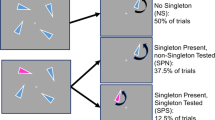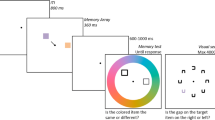Abstract
Recent evidence shows that when the contents of visual working memory overlap with targets and distractors in a pop-out search task, intertrial priming is inhibited (Kristjánsson, Sævarsson & Driver, Psychon Bull Rev 20(3):514–521, 2013, Experiment 2, Psychonomic Bulletin and Review). This may reflect an interesting interaction between implicit short-term memory—thought to underlie intertrial priming—and explicit visual working memory. Evidence from a non-pop-out search task suggests that it may specifically be holding distractors in visual working memory that disrupts intertrial priming (Cunningham & Egeth, Psychol Sci 27(4):476–485, 2016, Experiment 2, Psychological Science). We examined whether the inhibition of priming depends on whether feature values in visual working memory overlap with targets or distractors in the pop-out search, and we found that the inhibition of priming resulted from holding distractors in visual working memory. These results are consistent with separate mechanisms of target and distractor effects in intertrial priming, and support the notion that the impact of implicit short-term memory and explicit visual working memory can interact when each provides conflicting attentional signals.



Similar content being viewed by others
Notes
A′ is derived from the more traditional d′ but is more accurate for tasks of this sort and is more robust to lacks of false alarms. It is calculated as follows: \(A^{\prime } = 0.5 + \left[ {\frac{(H - FA)(1 + H - FA)}{4H(1 - FA)}} \right]\).
References
Arita, J. T., Carlisle, N. B., & Woodman, G. F. (2012). Templates for rejection: Configuring attention to ignore task-irrelevant features. Journal of Experimental Psychology-Human Perception and Performance, 38(3), 580–584. doi:10.1037/a0027885.
Ásgeirsson, Á. G., & Kristjánsson, Á. (2011). Episodic retrieval and feature facilitation in intertrial priming of visual search. Attention, Perception & Psychophysics, 73, 1350–1360.
Ásgeirsson, Á. G., Kristjánsson, Á., & Bundesen, C. (2014). Independent priming of location and color in identification of briefly presented letters. Attention, Perception & Psychophysics, 76, 40–48.
Ásgeirsson, Á. G., Kristjánsson, Á., & Bundesen, C. (2015). Repetition priming in selective attention: A TVA analysis. Acta Psychologica, 160, 35–42.
Bichot, N. P., & Schall, J. D. (2002). Priming in macaque frontal cortex during popout visual search: Feature-based facilitation and location-based inhibition of return. The Journal of Neuroscience, 22(11), 4675–4685.
Brinkhuis, M., Kristjansson, A., & Brascamp, J. (2016). Is search priming reflected in BOLD repetition suppression? Journal of Vision, 16(12), 1322.
Carlisle, N. B., & Woodman, G. F. (2011a). Automatic and strategic effects in the guidance of attention by working memory representations. Acta Psychologica, 137, 217–225. doi:10.1016/j.actpsy.2010.06.012.
Carlisle, N. B., & Woodman, G. F. (2011b). When memory is not enough: Electrophysiological evidence for goal-dependent use of working memory representations in guiding visual attention. Journal of Cognitive Neuroscience, 23(10), 2650–2664.
Carlisle, N. B., & Woodman, G. F. (2013). Reconciling conflicting electrophysiological findings on the guidance of attention by working memory. Attention Perception & Psychophysics, 75(7), 1330–1335. doi:10.3758/s13414-013-0529-7.
Cunningham, C. A., & Egeth, H. E. (2016). Taming the white bear initial costs and eventual benefits of distractor inhibition. Psychological Science, 27(4), 476–485.
Desimone, R., & Duncan, J. (1995). Neural mechanisms of selective visual attention. Annual Review of Neuroscience, 18, 193–222.
Donaldson, W. (1993). Accuracy of d′ and A′ as estimates of sensitivity. Bulletin of the Psychonomic Society, 31, 271–274.
Downing, P. (2000). Interactions between visual working memory and selective attention. Psychological Science, 11(6), 467–473.
Downing, P., & Dodds, C. (2004). Competition in visual working memory for control of search. Visual Cognition, 11(6), 689–703.
Eimer, M., Kiss, M., & Cheung, T. (2010). Priming of pop-out modulates attentional target selection in visual search: Behavioural and electrophysiological evidence. Vision Research, 50(14), 1353–1361.
Grier, J. B. (1971). Nonparametric indexes for sensitivity and bias: Computing formulas. Psychological Bulletin, 75, 424–429.
Huang, L., & Pashler, H. (2007). Working memory and the guidance of visual attention: Consonance-driven orienting. Psychonomic Bulletin & Review, 14(1), 148–153.
Kiyonaga, A., Egner, T., & Soto, D. (2012). Cognitive control over working memory biases of selection. Psychonomic Bulletin & Review, 19(4), 639–646.
Kristjánsson, Á., & Campana, G. (2010). Where perception meets memory: A review of repetition priming in visual search tasks. Attention, Perception, & Psychophysics, 72(1), 5–18.
Kristjánsson, Á., & Driver, J. (2005). Priming in vision: Target repetition effects, context effects and role reversal effects. Perception, 34(Suppl.), 40c.
Kristjánsson, Á., & Driver, J. (2008). Priming in visual search: Separating the effects of target repetition, distractor repetition and role-reversal. Vision Research, 48(10), 1217–1232.
Kristjánsson, Á., & Jóhannesson, Ó. I. (2014). How priming in visual search affects response time distributions: Analyses with ex-Gaussian fits. Attention, Perception, & Psychophysics, 76(8), 2199–2211.
Kristjánsson, Á., Saevarsson, S., & Driver, J. (2013). The boundary conditions of priming of visual search: From passive viewing through task-relevant working memory load. Psychonomic Bulletin & Review, 20(3), 514–521. doi:10.3758/s13423-013-0375-6.
Kristjánsson, Á., Vuilleumier, P., Schwartz, S., Macaluso, E., & Driver, J. (2007). Neural basis for priming of pop-out during visual search revealed with fMRI. Cerebral Cortex, 17(7), 1612–1624.
Kruijne, W., Brascamp, J. W., Kristjánsson, Á., & Meeter, M. (2015). Can a single short-term mechanism account for priming of pop-out? Vision Research, 115, 17–22. doi:10.1016/j.visres.2015.03.011.
Lamy, D., Antebi, C., Aviani, N., & Carmel, T. (2008). Priming of pop-out provides reliable measures of target activation and distractor inhibition in selective attention. Vision Research, 48(1), 30–41. doi:10.1016/j.visres.2007.10.009.
Lamy, D., Yashar, A., & Ruderman, L. (2010). A dual-stage account of inter-trial priming effects. Vision Research, 50(14), 1396–1401.
Lee, H., Mozer, M. C., & Vecera, S. P. (2009). Mechanisms of priming of pop-out: Stored representations or feature-gain modulations? Attention Perception & Psychophysics, 71(5), 1059–1071. doi:10.3758/APP.71.5.1059.
Maljkovic, V., & Nakayama, K. (1994). Priming of pop-out: I. Role of features. Memory & Cognition, 22(6), 657–672.
Olivers, C. N. L., Peters, J., Houtkamp, R., & Roelfsema, P. R. (2011). Different states in visual working memory: when it guides attention and when it does not. Trends in Cognitive Sciences, 15(7), 327–334. doi:10.1016/j.tics.2011.05.004.
Rorden, C., Kristjánsson, Á., Pirog-Revill, K., & Saevarsson, S. (2011). Neural correlates of inter-trial priming and role-reversal in visual search. Frontiers in Human Neuroscience, 5, 151.
Sigurdardottir, H. M., Kristjánsson, Á., & Driver, J. (2008). Repetition streaks increase perceptual sensitivity in visual search of brief displays. Visual Cognition, 16(5), 643–658.
Soto, D., Hodsoll, J., Rotshtein, P., & Humphreys, G. W. (2008). Automatic guidance of attention from working memory. Trends in Cognitive Sciences, 12(9), 342–348.
Wang, D., Kristjánsson, A., & Nakayama, K. (2005). Efficient visual search without top-down or bottom-up guidance. Perception & Psychophysics, 67(2), 239–253.
Woodman, G. F., & Luck, S. J. (2007). Do the contents of visual working memory automatically influence attentional selection during visual search? Journal of Experimental Psychology-Human Perception and Performance, 33(2), 363–377. doi:10.1037/0096-1523.33.2.363.
Acknowledgements
We would like to thank two anonymous reviewers for helpful suggestions on a previous version of this manuscript. This paper was supported by a Grant Nos. 152427 and 130575 from the Icelandic Research Fund (Rannís) and the Research Fund of the University of Iceland.
Author information
Authors and Affiliations
Corresponding author
Ethics declarations
Statement of human rights
All procedures performed in studies involving human participants were in accordance with the ethical standards of the institutional and/or national research committee and with the 1964 Helsinki declaration and its later amendments or comparable ethical standards.
Rights and permissions
About this article
Cite this article
Carlisle, N.B., Kristjánsson, Á. How visual working memory contents influence priming of visual attention. Psychological Research 82, 833–839 (2018). https://doi.org/10.1007/s00426-017-0866-6
Received:
Accepted:
Published:
Issue Date:
DOI: https://doi.org/10.1007/s00426-017-0866-6




